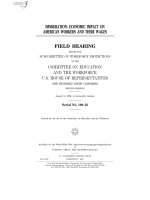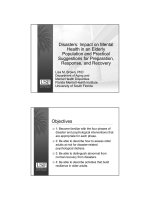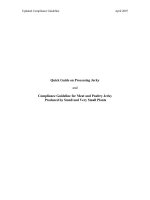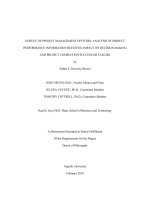Parameters impact on capital formation and key suggestions for the Krishi vigyan kendra''s in Nagaland
Bạn đang xem bản rút gọn của tài liệu. Xem và tải ngay bản đầy đủ của tài liệu tại đây (238.21 KB, 8 trang )
Int.J.Curr.Microbiol.App.Sci (2018) 7(11): 2679-2686
International Journal of Current Microbiology and Applied Sciences
ISSN: 2319-7706 Volume 7 Number 11 (2018)
Journal homepage:
Original Research Article
/>
Parameters Impact on Capital Formation and Key Suggestions for the
Krishi Vigyan Kendra's in Nagaland
Imsunaro Jamir and Amod Sharma*
Department of Agricultural Economics, Nagaland University SASRD Medziphema Campus,
District: Dimapur - 797 106, Nagaland, India
*Corresponding author
ABSTRACT
Keywords
KVK, Impact, Capital,
Formation, Parameter,
Selected
Article Info
Accepted:
22 October 2018
Available Online:
10 November 2018
The present study on impact assessment of Krishi Vigyan Kendra (KVK) training
programmes in Nagaland state was undertaken during the year 2012-13 to 2016-17 (five
years) and to assess the impact of income as well as employment generated it was
categorized into two groups viz., adopted and non-adopted villages (80 respondents to
each category). To achieve the objectives of the present study a multi stage purpose
random sampling methods was adopted. While for capital formation of the households
different parameters was selected viz., human capital, physical capital, social capital,
financial capital and food security all the five parameters were shown an increased in the
total contribution, even overall capital formation were indicating to increase from 51.82 to
69.00 per cent after taking the different schemes, projects, training programmes
implemented by both KVK's in the study areas. Substantially there were a decrease in the
percentage of respondents in low and medium groups, which was due to the shifting these
group towards the high capital formation groups, which shows positive impact and found
to be statistically significant at 1 and 5 per cent level.
Introduction
Agriculture is one of the significant
contributors to the Net State Domestic Product
and is the largest employer of the working
force in the state. Though the dependency of
employment on agriculture has declined from
as high as 96.50 per cent in the 1950s to about
68.00 per cent in 2000, it continues to be the
main source of livelihood. Shifting and
terraced cultivations remains the dominant
forms of land use practice in the state. The
traditional form of shifting cultivation i.e.
jhum, is the method of cultivation that is
widely practiced across Nagaland. Jhum
occupies about 90.00 per cent of the area
under agriculture. Terraced cultivation is
confined largely to the districts of Kohima,
Dimapur, Tuensang, Peren, Phek and Wokha.
The single cropping system is prevalent in the
state resulting in low cropping intensity.
Multiple cropping is yet to be practiced by
farmers except in very small and negligible
pockets.
The effectiveness of the KVK was further
enhanced by adding the activities related to
on-farm testing and Front-Line Demonstration
2679
Int.J.Curr.Microbiol.App.Sci (2018) 7(11): 2679-2686
on major agricultural technologies in order to
make the training of farmers location specific,
need based and resource-oriented. The training
programmes were designed to impart the latest
knowledge to the farmers through work
experience by applying the principles of
‘Teaching by Doing’ and ‘Learning by
Doing’. The prime goal of KVK is to impart
training as per needs and requirements in
agriculture and allied enterprises to all
farmers, farm women and farm youths
including school drop-outs in the rural area.
While designing the courses, the concept of
farming system as well as farming situation
are taken into account to ensure that the
enterprises in which they are trained are
commercially and ecologically viable,
sustainable and profitable. Such vocational
trainings help them to sustain themselves
through self-employment and to make them
self-reliant economically and thus discourages
them to migrate to the urban areas. KVKs
provide training not only in agriculture and
allied vocations but also in other incomegenerating activities that may supplement the
income of farm families. The methods
employed in training could be formal and nonformal or a combination of both, depending
upon the needs but emphasis remains to be on
work-experience. The programmes of each
KVK cover training, on-farm trials, frontline
demonstrations, agricultural extension and
livelihood activities. Keeping in view the
above fact, the present study is undertaken,
with the following two specific objectives viz;
(i) to study the Impact of KVK’s training in
terms of capital formation, and (ii) to suggests
the ways and means facing the constraints in
disseminating knowledge by the KVK’s.
Materials and Methods
The present study is to assess the impact of
KVK for disseminating the agriculture
technology to the farming community in
Nagaland state, which is working as per the
guidelines of Central Government with the
help of Ministry of Agriculture, Government
of India. The sampling design and analytical
techniques to be used in the light of objectives
laid down for the study have been presented
under the following sub-headings.
Selection of districts
The KVK was launched in 1988-89 in all 11
districts viz; Dimapur, Kohima, Kiphire,
Longleng, Mokokchung, Mon, Phek, Peren,
Tuensang, Wokha and Zunheboto of
Nagaland, out of these districts two district
viz; Mokokchung and Zunheboto districts of
Nagaland have been selected because of the
fact that it is expected to provide all the
relevant information and hence can
conveniently be obtained for conducting this
study. The project area also has a good
network of infrastructure and allied activities
related to the scheme such as development
agencies, nationalized banks, well-established
marketing and communication facilities etc.
Keeping all the above facts, both districts of
Nagaland are therefore purposively selected to
conduct this study.
Selection of blocks
Two blocks from each district will be selected
randomly for the present study as these blocks
are well covered by KVK programmes.
Selection of villages
Altogether eight villages were selected
randomly from each district, while four
villages from each block were selected and
listed which would be obtained from the
offices of SDO (Civil), R. D. block
headquarter and other related offices.
However, it is proposed to select four villages
from each block randomly covered for KVK
programme / schemes.
2680
Int.J.Curr.Microbiol.App.Sci (2018) 7(11): 2679-2686
Selection of farmers
Results and Discussion
After selection of the villages, a list of
beneficiaries and non-beneficiaries of KVK
will be prepared from each of the selected
village. In order to have representative sample
from each village a sample of 20 numbers of
cases of KVK, out of that 10 from
beneficiaries and 10 from non-beneficiaries
will be drawn following the purposively
random sampling method.
The present results and discussion was
collected from the selected KVK’s adopted
and non-adopted farmers. The data were
analysed as per the requirement of the stated
objectives.
This will result in selection of 160 respondents
from 8 villages, out of which 80 will be
beneficiaries of KVK schemes and 80 will be
non-beneficiaries of KVK schemes.
Analytical techniques and tools
Collected data will be scrutinized, tabulated
and processed systematically according to the
objectives laid down for the study.
Tabular and functional analysis will be used to
meet the objectives of the study as and where
needed, data were analysed by tabular
presentation method where frequencies and
percentages were used, mean, standard
deviations were used to categorise the sample.
Impact index was used to find the extent of
KVK's training / programme for adopted and
non-adopted both groups. Frequency and
percentage were used for tabular analysis.
Mean and standard deviation were computed
to categorize the respondents.
Paired ‘t’ test was used to know the
significance of difference in Impact
assessment before and after taking income
generating activity. The chi-square analysis
was used to find the association between
different activities and socio-economic
characteristics of respondents. Modified chisquare values were calculated for the data
where cell frequencies were less than five.
Table 1 reveals the change in Overall
formation factors due to the enhancement of
income (Rs) and employment generation
(manday). Data clearly indicates an increase
from Overall Capital Worth on age (24.70 per
cent), occupation (66.70 per cent), farm size
(89.60 per cent), social participation (32.50
per cent), mass media (85.30 per cent),
economic motivation (61.00 per cent), Credit
facilities (72.50 per cent), farming experience
(73.20 per cent), technology (71.20 per cent),
annual income (91.10 per cent) and
employment (82.70 per cent). All the variables
were found to be significant at 1 per cent level
of significance. Even the extension contact
(14.90 per cent) was found to be significant at
5 per cent level of significance. Education
(9.40 per cent) was found to be non-significant
but positive, whereas the family size (-24.70
per cent) was found to be negative significant
at 1 per cent level of significance which is an
indication of negative correlation / reverse
impact due to the large /big family size to gain
better income / employment based training /
programme conducted by the KVK's in the
study area. As per Human Capital (HC)
aspect, before it was 47.50 per cent and after
getting programme / training it has increased
up to 71.25 per cent, which was found to be
significant at 1 per cent level of significance.
On Physical Capital (PC) aspect, before it was
48.75 per cent and after getting programme /
training it has increase up to 62.50 per cent
which was found to be significant at 1 per cent
level of significance.
Table 1 reveals that the human capital for age
(23.60 per cent), occupation (62.70 per cent),
2681
Int.J.Curr.Microbiol.App.Sci (2018) 7(11): 2679-2686
farm size (85.60 per cent), social participation
(30.20 per cent), mass media (81.60 per cent),
extension contact (18.40 per cent), economic
motivation (56.20 per cent), Credit facilities
(66.00 per cent), farming experience (67.50
per cent), technology (66.80 per cent), annual
income (88.40 per cent) and employment
(77.70 per cent). All the above variables were
found to be significant at 1 per cent level of
significance. However, education (10.40 per
cent) was found to be non-significant but
positive whereas, the family size (-22.60 per
cent) was found to be negative significant at 1
per cent level of significance.
Further data reveals the physical capital for
occupation (57.40 per cent), farm size (71.10
per cent), social participation (23.10 per cent),
mass media (69.40 per cent), economic
motivation (49.60 per cent), Credit facilities
(60.90 per cent), farming experience (60.70
per cent), technology (56.70 per cent), annual
income (75.60 per cent) and employment
(81.30 per cent). All the variables were found
to be significant at 1 per cent level of
significance and both age (14.30 per cent) and
extension contact (2.22 per cent) were found
to be significant at 5 per cent level of
significance; while the education (10.40 per
cent) was found to be non-significant but
positive. The family size (-22.60 per cent) was
found to be negative significant at 1 per cent
level of significance.
Table further reveals the social capital for age
(23.60 per cent), occupation (62.70 per cent),
farm size (85.60 per cent), social participation
(30.20 per cent), mass media (81.60 per cent),
extension contact (18.40 per cent), economic
motivation (56.20 per cent), Credit facilities
(66.00 per cent), farming experience (67.50
per cent), technology (66.80 per cent), annual
income (88.40 per cent) and employment
(77.70 per cent). All the above variables were
found to be significant at 1 per cent level of
significance. However, education (10.40 per
cent) was found to be non-significant but
positive and family size (-22.60 per cent) was
found to be negative significant at 1 per cent
level of significance.
Table further reveals the financial capital for
the age (22.20 per cent), occupation (62.50 per
cent), farm size (84.00 per cent),social
participation (33.70 per cent), mass media
(78.40 per cent), economic motivation (62.30
per cent), Credit facilities (73.90 per cent),
farming experience (72.40 per cent),
technology (67.50 per cent), annual income
(79.80 per cent) and employment (70.30 per
cent). All the above variables were found to be
significant at 1 per cent level of significance.
Extension contact (11.90 per cent) and
education (12.00 per cent) both were found to
be non-significant but positive whereas, the
family size (-24.60 per cent) was found to be
negative significant at 1 per cent level of
significance.
Table further reveals the Food Security for the
age (28.40 per cent), occupation (62.00 per
cent), farm size (85.00 per cent),social
participation (32.00 per cent), mass media
(80.60 per cent), economic motivation (56.90
per cent), credit facilities (68.00 per cent),
farming experience (69.40 per cent),
technology (69.00 per cent), annual income
(85.90 per cent) and employment (74.60 per
cent). All the above variables were found to be
significant at 1 per cent level of significance.
Extension contact (15.10 per cent) was found
to be significant at 5 per cent level of
significance, while education (7.10 per cent)
was found to be non-significant but positive.
However, family size (-22.60 per cent) was
found to be negative significant at 1 per cent
level of significance.
On other functioning of the KVK's training /
programmes, 3 (1.88 per cent) have ideas and
responses which is of non-adopted KVK’s
respondents only.
2682
Int.J.Curr.Microbiol.App.Sci (2018) 7(11): 2679-2686
Table.1 Relationship with independent variable with capital formation factors
S. N.
1.
2.
3.
4.
5.
6.
7.
8.
9.
10.
11.
12.
13.
14.
Independent variables
Age
Education
Occupation
Farm size
Family size
Social participation
Mass media
Extension contact
Economic motivation
Credit facilities
Farming experience
Technology
Annual income
Employment
HC
0.236**
0.104NS
0.627**
0.856**
-0.226**
0.302**
0.816**
0.184**
0.562**
0.660**
0.675**
0.668**
0.884**
0.777**
PC
0.143*
0.031 NS
0.574**
0.710**
-0.123NS
0.231**
0.694**
0.022NS
0.496**
0.609**
0.607**
0.567**
0.756**
0.813**
SC
0.236**
0.104 NS
0.627**
0.856**
-0.226**
0.302**
0.816**
0.184**
0.562**
0.660**
0.675**
0.668**
0.884**
0.777**
FC
0.222**
0.120 NS
0.625**
0.840**
-0.246**
0.337**
0.784**
0.119NS
0.623**
0.739**
0.724**
0.675**
0.798**
0.703**
FS
0.284**
0.071NS
0.620**
0.850**
-0.226**
0.320**
0.806**
0.151*
0.569**
0.680**
0.694**
0.690**
0.859**
0.746**
Overall
0.247**
0.094NS
0.667**
0.896**
-0.223**
0.325**
0.853**
0.149*
0.610**
0.725**
0.732**
0.712**
0.911**
0.827**
(** & * Significant at 1& 5 per cent level of significant, NS: Non-significant)
Table.2 Suggestion given by adopted villages for the KVK's in the study area
S. No.
1.
2.
3.
4.
5.
6.
7.
8.
9.
10.
11.
12.
13.
14.
15.
16.
17.
18.
19.
20.
21.
Suggestions
Training programme conducted at block level
KVK office release improved variety
Production technology given in time
Financial facilities given in time
Government assistance within time frame
Farmers should maintain their land holding
Training centre / institutes at block level
Need based training may be given
Irrigation sources should be increased
Efforts should be made of irrigation water
Roads and transport facilities to be improved
Government livelihood activity encouraged
Skill based training programmes encouraged
Success story / case study must be encouraged
Mechanization must be encouraged
Documentation should be strong
Locally made commodity should be encouraged
Post-harvest management should be encouraged
Information centre should be established
Saving habit should be encouraged
Metrological station should be established
2683
Number
68
67
65
62
58
58
56
54
52
50
45
45
43
38
36
32
32
28
23
21
18
Percentage Rank
85.00
I
83.75
II
81.25
III
77.50
IV
72.50
V
72.50
V
70.00
VI
67.50
VII
65.00
VIII
62.50
IX
56.25
X
56.25
X
53.75
XI
47.50
XII
45.00
XIII
40.00
XIV
40.00
XIV
35.00
XV
28.75
XVI
26.25
XVII
22.50
XVIII
Int.J.Curr.Microbiol.App.Sci (2018) 7(11): 2679-2686
On N/A functioning of the KVK's training /
programmes, 2 (1.25 per cent) have ideas and
responses which is of non-adopted KVK’s
respondents.
Further the KVK's also provide the training /
activities on the following aspects but due to
lack of data base it was difficult to record all
those but in coming days it will be covered:
Backward linkage
Seed supply status
Seed certification facilities
Fertilizer
Machine and tools facilities
Credit facilities
Labour status
block levelby 68 (85.00 per cent) in the study
area, then the second highest by 67 (83.75 per
cent) who are in the view that the KVK office
release improved variety deemed fit to the
local areas, the production technology given
in time by 65 (81.25 per cent) as third
suggestions, while the forth suggestion is,
financial facilities must be given in time by
62 (77.50 per cent) and the fifth suggestion by
58 (72.50 per cent) for government assistance
within time frame and farmers should
maintain their land holdings respectively.
The sixth suggestion was based on the
training centre / institutes which must be at
block level by 56 (70.00 per cent) in the study
area, 54 (67.50 per cent) felt that the KVK
office must provide need based training not as
per the Central / State Government directives,
Forward linkage
Manure status
Storage facilities
Transportation facilities
Agro-based industries
Labour status.
Table 2 an attempt is made to identify the
ssuggestions given by adopted villages for the
KVK's in the study area for making the
training / programme more effective for
implementing the schemes in the KVK's
adopted villages which are presented in the
table shown with frequency and simple
percentage and then it has been ranked using
the Garrett’s ranking technique. The
analytical findings has been found almost
similar across various farm size groups so it
was recorded as overall / average views of the
respondents. Therefore, the suggestions are
not discussed according to different size
group of farmers, rather the sample farmer as
a whole.
Among suggestions, the foremost is that,
training programme may be conducted at
Instead it should be need based and useful as
seventh suggestion, further eighth suggestion
is by 52 (65.00 per cent) respondents who
feltthe need / importance of irrigation sources
so as to achieve the goal of doubling the
farmers income by Central government and
the ninth suggestions is given by 50 (62.50
per cent) who suggested that efforts
(investment)must be encouraged for the
irrigation water facilities and the tenth
suggestion by 45 (56.25 per cent) for
improving the road conditions and transport
facilities so as to encourage livelihood
activity respectively.
The eleventh suggestion is to develop the skill
based training programmes by 43 (53.75 per
cent) respondents, twelfth suggestions is to
encourage the success story / case study by 38
(47.50 per cent) while, mechanization to be
encouraged by 36 (45.00 per cent) asthe
thirteenth suggestions and by 32 (40.00 per
cent)
as
fourteen
suggestion
for
documentation to be strong followed by
locally made commodity to be encouraged for
getting good livelihood activity respectively.
2684
Int.J.Curr.Microbiol.App.Sci (2018) 7(11): 2679-2686
The fifteen suggestions is to develop the postharvest management by 28 (35.00 per cent),
the sixteen suggestion given by 23 (28.75 per
cent) felt that information centre should be
established at block level to provide the
information in time related to agriculture and
allied activities to the concern household for
improving the efficiency and utility, further
seventeen suggestion is given by 21 (26.25
per cent)as savings to be encouraged and the
last eighteen suggestion is given by 18 (22.50
per cent)that the metrological station should
be established at block / district level due to
climatic effect on the production and
productivity respectively.
From the present study the main conclusions
emerge as per the study entitled was the
parameters for overall capital formation in
terms of income and employment include
Human Capital (HC), Physical Capital (PC),
Social Capital (SC), Financial Capital (FC)
and Food Security (FS). After KVK training
programmes, it has increased up to 69.00 per
cent which was found to be significant at 1
per cent level of significance of paired ‘t’ test
indicating a positive impact on income and
employment.
References
Analogous. 2017. Statistical Hand of
Nagaland Published by Directorate of
Economics and Statistics (various
issues), Kohima, Nagaland.
Pongener, Bendangjungla. and Sharma,
Amod. 2018. Constraints Faced by the
Fishery Enterprises: A SWOC Analysis.
IJCMAS. 7(5). May: 1595-1603.
Sangtam, Likhase. L. T. and Sharma, Amod.
2015. Impact of Bank Finance on
Employment and Income through
Piggery Enterprise in Nagaland.
EPRAIJEBR. 3(11). Nov: 273-276.
Sharma, A. 2002. Source and Knowledge on
beneficiaries about the purpose of credit
- A case study of Agra Region of Uttar
Pradesh. Journal of Interacademica.
6(3). July: 374-379.
Sharma, A. 2004. Constraints of Fish
Production - A case study in rainfed
areas of Uttar Pradesh. Journal of
Interacademica. 8(4). October: 639643.
Sharma, A. and Sharma, Anamika. 2008.
Problems faced by the farmers in
adoption of improved maize cultivation
practices in hills. TJRAR. 8(2): 22-23.
Sharma, Amod. 2011. Economic and
Constraints of King Chilli Growers in
Dimapur District of Nagaland. Journal
of Interacademicia. 15(4): 710-719.
Sharma, Amod. 2012. Inter-state Disparities
in Socio-economic Development in
North East Region of India. Journal of
Agricultural Science. 4(9). September:
236-243.
Sharma, Amod. 2014. Sustainable economic
analysis and extent of satisfaction level
of King Chilli growers in Nagaland.
Agriculture
for
Sustainable
Development. 2(1). June: 188-191.
Sharma, Amod.; Kichu, Yimkumba. and
Chaturvedi, B. K. 2016. Economics and
Constraints of Pineapple Cultivation in
Dimapur District of Nagaland. TJRAR.
16(1). January: 72-75.
Sharma, Amod.; Kichu, Yimkumba. and
Sharma, Pradeep. Kumar. 2018.
Sustainable economic analysis and
constraints faced by the pineapple
growers in Nagaland. Progressive
Agriculture. 18(1). February: 27-33.
Shuya, Keviu. and Sharma, Amod. 2014.
Impact and constraints faced by the
borrowers of cooperative bank finance
in Nagaland. Economic Affairs. 59(4).
October: 561-567.
Shuya, Keviu. and Sharma, Amod. 2018.
Problems faced by the Borrowers in
Utilization
and
Acquiring
of
2685
Int.J.Curr.Microbiol.App.Sci (2018) 7(11): 2679-2686
Cooperative Bank Loans in Nagaland.
IJED. 14(2). April-June: 52-56.
Tangjang, Avicha. and Sharma, Amod. 2018.
Problem faced by the Large Cardamom
Growers during production and
marketing: A case study of Tirap district
of Arunachal Pradesh. IJCMAS. 7(5).
May: 2561-2573.
Walling, Imti. and Sharma, Amod. 2015.
Impact of SGRY on beneficiaries and
non-beneficiaries in Dimapur district of
Nagaland. TJRAR. 15(2). August: 9094.
Walling, Imti.; Sharma, Amod.; Yadav,
Mukesh. Kumar.; Rajbhar, Arun,
Kumar. and Kalai, Kankabati. 2017.
Impact of Agricultural Technology
Management
Agency
on
Rural
Economy of Nagaland, India. Plant
Archiver. 17(2). October: 1511-1516.
How to cite this article:
Imsunaro Jamir and Amod Sharma. 2018. Parameters Impact on Capital Formation and Key
Suggestions for the Krishi Vigyan Kendra's in Nagaland. Int.J.Curr.Microbiol.App.Sci. 7(11):
2679-2686. doi: />
2686









